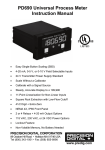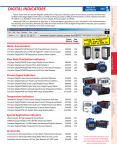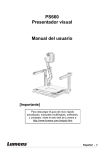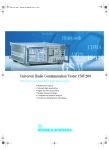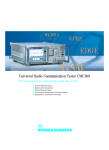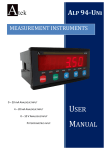Download PRECISION DIGITAL PD756 Instruction manual
Transcript
D I G I TA L PA N E L M E T E R S Universal Temperature Meters Model PD750, PD751, PD752 Instruction Manual • J, K, T, E, R, and S Thermocouples • 100 Ω Platinum RTD • 10 Ω Copper RTD • 120 Ω Nickel RTD • Displays °F or °C • Factory Calibrated for All Inputs • Type T T/C and RTDs Displayed to 0.1° • NEMA 4X, IP65 Front Panel • 115 VAC, 230 VAC, or 24 VDC Power Options • 2 or 4 Relays + 4-20 mA Output Option ¨ UL Listed (PD750 AC Powered Units Only) PRECISION DIGITAL CORPORATION 19 Strathmore Road • Natick MA 01760 USA Tel (800) 610-5239 • Fax (508) 655-8990 www.predig.com Model PD750, PD751, PD752 Universal Temperature Meters TABLE OF CONTENTS Instruction Manual SPECIFICATIONS . . . . . . . . . . . . . . . . . . . . . . . . . . . . . . . . . . . . . . . . . . . . . . . . . . .4 OPTIONS . . . . . . . . . . . . . . . . . . . . . . . . . . . . . . . . . . . . . . . . . . . . . . . . . . . . . . . . . .5 SETUP . . . . . . . . . . . . . . . . . . . . . . . . . . . . . . . . . . . . . . . . . . . . . . . . . . . . . . . . . . . .6 POWER and SIGNAL CONNECTIONS . . . . . . . . . . . . . . . . . . . . . . . . . . . . . . . . . . .6 PROGRAMMING . . . . . . . . . . . . . . . . . . . . . . . . . . . . . . . . . . . . . . . . . . . . . . . . . . . .8 CALIBRATION FLOW CHART . . . . . . . . . . . . . . . . . . . . . . . . . . . . . . . . . . . . . . . . . .9 CALIBRATION ([ALIb) . . . . . . . . . . . . . . . . . . . . . . . . . . . . . . . . . . . . . . . . . . . . . .10 INPUT TYPE (TYPE) . . . . . . . . . . . . . . . . . . . . . . . . . . . . . . . . . . . . . . . . . . . . . . . .11 SCALE (F or [) . . . . . . . . . . . . . . . . . . . . . . . . . . . . . . . . . . . . . . . . . . . . . . . . . . . .12 4 ALARM POINTS (Alars) . . . . . . . . . . . . . . . . . . . . . . . . . . . . . . . . . . . . . . . . . . .13 FAIL-SAFE OPERATION . . . . . . . . . . . . . . . . . . . . . . . . . . . . . . . . . . . . . . . . . . . . .15 RELAYS (Optional) . . . . . . . . . . . . . . . . . . . . . . . . . . . . . . . . . . . . . . . . . . . . . . . . . .16 SWITCHING INDUCTIVE LOADS . . . . . . . . . . . . . . . . . . . . . . . . . . . . . . . . . . . . . .17 ISOLATED 4-20 mA OUTPUT OPTION (OvtPvt) . . . . . . . . . . . . . . . . . . . . . . . . .18 LOCKOUT . . . . . . . . . . . . . . . . . . . . . . . . . . . . . . . . . . . . . . . . . . . . . . . . . . . . . . . .20 MOUNTING DIMENSIONS . . . . . . . . . . . . . . . . . . . . . . . . . . . . . . . . . . . . . . . . . . .20 OPTION CARD INSTALLATION . . . . . . . . . . . . . . . . . . . . . . . . . . . . . . . . . . . . . . .21 OTHER PRECISION DIGITAL PRODUCTS . . . . . . . . . . . . . . . . . . . . . . . . . . . . . .23 DEFINITIONS TYPE, INPUT TYPE: To program unit for input type,(i.e. T/C or RTD). F or [, Fahrenheit or Celsius: To program unit for Fahrenheit or Celsius display. [ALIb, CALIBRATION: To re-calibrate unit using a calibrated signal source. Alars, ALARM and RELAY POINTS: Sets alarm and relay set and reset points. 0vtPvt, 4-20 mA OUTPUT OPTION: Programs optional 4-20 mA output values. Error, ERROR: Calibration not successful. 0PEN, OPEN T/C: Open thermocouple circuit indicated by flashing display. ! WARNING Hazardous voltages exist within enclosure. Installation and service should be performed only by trained service personnel. ! AVERTISSEMENT Les pièces à l'intérieur du boîtier portent des tensions dangereuses. Seules des personnes qualifiées et bien entrainées devraient entreprondre l'ótalonnage et la maintenance. Notice The information contained in this document is subject to change without notice. www.predig.com 2 Model PD750, PD751, PD752 Universal Temperature Meters ORDERING INFORMATION Instruction Manual Type J, K, T, E, R, S, and 100 Ω Platinum RTD : 115 VAC Model PD750-3-N PD750-3-14 PD750-3-15 PD750-3-16 230 VAC Model PD750-4-N PD750-4-14 PD750-4-15 PD750-4-16 24 VDC Model PD750-2-N PD750-2-14 PD750-2-15 PD750-2-16 PD750-3-17 PD750-3-18 PD750-4-17 PD750-4-18 PD750-2-17 PD750-2-18 115 VAC Model PD751-3-N PD751-3-14 PD751-3-15 PD751-3-16 230 VAC Model PD751-4-N PD751-4-14 PD751-4-15 PD751-4-16 24 VDC Model PD751-2-N PD751-2-14 PD751-2-15 PD751-2-16 PD751-3-17 PD751-3-18 PD751-4-17 PD751-4-18 PD751-2-17 PD751-2-18 115 VAC Model PD752-3-N PD752-3-14 PD752-3-15 PD752-3-16 230 VAC Model PD752-4-N PD752-4-14 PD752-4-15 PD752-4-16 24 VDC Model PD752-2-N PD752-2-14 PD752-2-15 PD752-2-16 PD752-3-17 PD752-3-18 PD752-4-17 PD752-4-18 PD752-2-17 PD752-2-18 Options Installed No Options 2 Relays 4-20mA Out 2 Relays + 4-20 mA Out 4 Relays 4 Relays + 4-20 mA Out Option Card* PD174 PD175 PD176 PD177 PD178 10 Ω Copper Options Installed No Options 2 Relays 4-20mA Out 2 Relays + 4-20 mA Out 4 Relays 4 Relays + 4-20 mA Out Option Card* PD174 PD175 PD176 PD177 PD178 120 Ω Nickel Options Installed No Options 2 Relays 4-20mA Out 2 Relays + 4-20 mA Out 4 Relays 4 Relays + 4-20 mA Out Option Card* PD174 PD175 PD176 PD177 PD178 Ordering example: PD750-3-14, temperature meter powered from 115 VAC (-3) with 2 relays (-14). 3 www.predig.com Model PD750, PD751, PD752 Universal Temperature Meters SPECIFICATIONS Instruction Manual Basic Meter INPUTS: PD750: Field selectable: type J, K, T, E, R, or S Thermocouples with 1° resolution; type T to 0.1° 100 Ω platinum RTD (.00385 or .00392 curve) to 1° or 0.1° resolution. PD751: 10 Ω copper RTD PD752: 120 Ω nickel RTD DISPLAY: Bright, large, 0.56” (14.2mm) high efficiency red, 41/2 digits. F or C may be switched on to indicate Fahrenheit or Celsius. COLD JUNCTION REFERENCE: Automatic, fixed, no user calibration needed. SENSOR BREAK DETECTION: Open sensor circuit indicated by display flashing 0pen. All relays and alarm status LEDs go to alarm state. HOLD READING: Connect switch to ACK/HLD and COM terminals, also connect jumper pins on rear. ACCURACY: See Thermocouple and RTD chart, page 11. LOCKOUT: Jumper JP2 at rear of instrument restricts modification of calibration values. INPUT IMPEDANCE: Greater than 100 KΩ. POWER: AC power: 115 VAC ±10%, 50/60 Hz, 10 VA. 230 VAC ±10%, 50/60 Hz, 10 VA. DC power: 22-28 VDC, 6 watts max. ISOLATION: AC power: 1500 VAC; DC power: 500 VDC. NORMAL MODE REJECTION: 64 dB at 50/60 Hz ENVIRONMENTAL: Operational ambient temperature range: 0 to +60°C. Storage temperature range: -40 to +85°C. Relative humidity: 0 to 90% non-condensing. ENCLOSURE: 1/8 DIN, high impact plastic, UL 94V-0. FRONT PANEL: NEMA 4X, IP65, panel gasket provided. WEIGHT: 19.7 oz (559 g) (including options) CONNECTIONS: Removable screw terminal block, accepts #22 to #12 AWG. ALARM POINTS: 4, any combination of high or low alarms. ALARM STATUS INDICATION: Front panel LED ALARM DEADBAND: 0-100% of full scale, user selectable. UL FILE NUMBER: E160849; 508 Industrial Control Equipment (PD750 AC Powered Unit only) www.predig.com 4 Model PD750, PD751, PD752 Universal Temperature Meters OPTIONS Instruction Manual Relays RATING: 2 or 4 SPDT (form C); rated 2 Amp @ 30 VDC or 2 Amp @ 250 VAC resistive load; 1/14 HP @ 125 / 250 VAC for inductive loads. RESET: User select. 1. Automatically when the input passes the reset point. 2. Automatically + manually (via user supplied switch or front panel ACK button). Manual reset resets all manually resetable relays. FAIL-SAFE OPERATION: The relay coils are energized in the non-alarm condition. In the case of a power failure, the relays will go to the alarm state. Fail-safe operation by removing jumper J2 located on the Options Board. AUTO INITIALIZATION: When power is applied to the meter, the relays will always reflect the state of the input to the meter. DEADBAND: 0-100%, User selectable. Isolated 4-20 mA Transmitter Output CALIBRATION RANGE: The transmitter output can be calibrated so that a 4 mA output is produced for any number displayed on the meter. The 20 mA output may correspond to any number displayed on the meter above or below the 4 mA output display. OUTPUT LOOP RESISTANCE: Power supply: minimum maximum 24 VDC 10 Ω 600 Ω 35 VDC (external) 600 Ω 1000 Ω ACCURACY: ± 0.1% F.S., ± .004 mA. ISOLATION: 500 VDC or peak AC, input-to-output or input/output-to-power line. EXTERNAL LOOP POWER SUPPLY: 35 V max. WARRANTY: 2 years parts & labor EXTENDED WARRANTY: 1 or 2 years, refer to the Price List for details. 5 www.predig.com Instruction Manual Model PD750, PD751, PD752 Universal Temperature Meters SETUP Programming and installing the meter involves six basic steps. Step 1 Step 2 Remove jumper JP2 if installed, to disable the lockout feature. Configure the input signal jumper JP1 according to the input type, thermocouple or RTD, see charts below. Connect the input signal according to the chart below. Connect power. Program the input type, choice 0-10, see page 11. Program the scale type, Fahrenheit or Celsius, see page 12. Step 3 Step 4 Step 5 Step 6 POWER and SIGNAL CONNECTIONS 24 V Transmitter power: P+, P- For DC powered units see diagrams on page 7 No Connection RTD A AC IN MK C A S C O I K C I K C G / K G / K N H O N H O A L U A L L D T L D T AC L L P+P- C A E + Ð JP2 O C X JP1 / H H L L Four-Wire RTD Connections JP2 JP1 Three-Wire RTD Connections T/C RTD A S I M K C U D D L L P+P- C A E + Ð O C X IN IN MK C / AC L C O L L P+P- C A E + Ð O C X RTD L S L A C O K C S I K L C O C K K G / N H O G / N H O A L U A L L D T L D T AC L L P+P- C A E + Ð O C X IN JP2 JP1 M K C / / H H L L D U JP2 JP1 D Two-Wire RTD Connections Thermocouple Connections 6 Model PD750, PD751, PD752 Universal Temperature Meters Instruction Manual POWER and SIGNAL CONNECTIONS for DC POWERED UNITS No Connection RTD A 22-28 VDC V-V+ C O I K C G / K N H O IN M K C A A L L C / U A L D T L D T V-V+ JP2 C A E + Ð O C X JP1 IN M K C K U JP2 JP1 Three-Wire RTD Connections T/C A 22-28 VDC IN A L L S C O S C O I K C I K G / K N H O A L L C G / N H O U A L D T L D T C A E + Ð M K C I H O RTD O C X C O K G 22-28 VDC Four-Wire RTD Connections V-V+ L S N C A E + Ð O C X RTD L S 22-28 VDC V-V+ JP2 C A E + Ð O C X JP1 M K C Two-Wire RTD Connections K U JP2 IN JP1 Thermocouple Connections WIRING INSTRUCTIONS 1. All field connections to be made with either solid or stranded insulated wire. Strip length = 1/4" (7 mm). Tighten screw terminals to 4.5 lb-in (0.5 Nm). Do not pre-treat wire with solder. 2. Terminals connected to line voltage (e.g. L, RELAY 1-4): Use AWG # 12-18 copper wire, 600 volt, 60°C or 60/75°C. Connect only one wire to each terminal. 3. Terminals not connected to line voltage (e.g. IN, EXC, ACK, COM, P+, P-, V+, V-, +, -): Use AWG #12-22 wire. If using AWG #20 or smaller wire, up to two wires may be connected to each terminal. If using AWG #18 or larger wire, only one wire may be connected to each terminal. 7 www.predig.com Model PD750, PD751, PD752 Universal Temperature Meters PROGRAMMING Instruction Manual The meter’s Single Button Scaling feature allows it to be programmed using only the ENTER button. The general procedure is to press the ENTER button to accept a flashing display or to wait for the display to scroll and press ENTER when the desired display appears. For instance when the ENTER button is pressed, the meter scrolls through the standard programming routine titles: [ALIb , TYPE, F or [, Alars. It will also scroll the optional programming routine title: OvtPvt if the meter contains the isolated 4-20 mA Output Option. To enter a programming routine, press ENTER when the meter displays the desired programming routine title. The following flow chart overviews the meter programming routines. Display scrolls programming routines. Press ENTER Press ENTER to select desired routine. Press Press Press Press Press ENTER ENTER ENTER ENTER ENTER 2 point Calibration Set Decimal Point Program Alarms (AL IB appears if E-(AL is selected appears if I-(AL isinstructions selected There are 5S(ALE basic programming * Program Calibrate Noise 4-20 mA Filter Output ** Only appears if 4-20 mA output is installed 1. If the flashing display is OK, press ENTER before it stops flashing to accept it. 2. If the flashing display is not OK, (or if ENTER was not pressed in time to accept it), wait for first digit to flash. 3. If a flashing digit is OK press ENTER before it starts to scroll to accept it. 4. If a flashing digit is not OK, (or if ENTER was not pressed in time to accept it), wait for the digit to scroll, and press ENTER when OK. 5. Digits will scroll until ENTER is pressed. When a digit is accepted by pressing ENTER, the next digit flashes. For best results, allow the meter to warm up for at least 30 minutes before calibrating. www.predig.com 8 Model PD750, PD751, PD752 Universal Temperature Meters CALIBRATION FLOW CHART Instruction Manual The following flow chart illustrates a 2 point calibration using Single Button Scaling. The same general procedure is used for alarm set and reset point programming and 4-20 mA output programming. Press ENTER Press ENTER when appears flashes Apply input 1 signal (e.g. 2 V) flashes apply input 2 Press ENTER (e.g. 20 V) Is entire flashing YES Press ENTER display OK? NO Has Wait for input 2 been digit to flash NO calibrated yet? YES Wait for digit to scroll NO Is Calibration the flashing Complete! digit OK? YES Press ENTER when OK Press ENTER Is entire display NO flashing? YES 9 www.predig.com Model PD750, PD751, PD752 Universal Temperature Meters CALIBRATION ((ALIb) Instruction Manual The PD750 is pre-calibrated for 6 types of thermocouples and 2 types of 100 Ω RTD sensors. The PD751 is pre-calibrated for 10 Ω copper RTD sensors and the PD752 is pre-calibrated for 120 Ω nickel RTD sensors. These input ranges may be re-calibrated and should be checked every 12 months. Calibration is performed from the front panel using the ENTER button. It does not require any tools or disassembly of the meter. The only equipment needed is a thermocouple calibrator or a 5 decade resistance box with an accuracy of about 0.1% and a minimum resistance of 0.01 Ω for RTDs. Go to INPUT TYPE on page 11 if calibration is not necessary. Input 1 Calibration 1. Press ENTER, when [ALIb appears press ENTER again. 2. Meter flashes iNPT1. Apply input 1 (low signal) using a calibrator, THEN press ENTER. 3. All digits flash for 3 seconds. If this is the desired display for input 1, press ENTER before entire display stops flashing, (meter will then flash InPt 2). Go to step 9 below. If this is not the desired display, (or if ENTER was not pressed in time to accept the display) wait for the first digit to flash. First digit flashes for 3 seconds before it scrolls. 4. When digit is OK, press ENTER, next digit will flash for 3 seconds before it scrolls. 5. When flashing digit is OK, press ENTER, next digit will flash for 3 seconds before it scrolls. 6. Repeat step 4 for each remaining digits. 7. When last digit is OK, press ENTER. 8. Entire display will flash for 3 seconds. Press ENTER within the 3 seconds if OK to complete input 1 calibration. If not OK, wait for first digit to flash and go to step 3 above. 9. Meter flashes iNPT 2. Apply input 2 (high signal) using a calibrator, THEN press ENTER. 10. GO TO STEP 3 ABOVE. Calibration Error An Error message during calibration indicates that the calibration process was not successful. The meter should be recalibrated. An Error message will appear if input 1 and input 2 signals are within 4 millivolts. An Error message will appear if input 1 signal is inadvertently also applied for input 2 calibration, or ENTER is pressed before applying input 2. 10 Model PD750, PD751, PD752 Universal Temperature Meters INPUT TYPE (TYPE) Instruction Manual The meter must be programmed for the input type it is to accept. Selecting the wrong input type will cause an incorrect temperature to be displayed. Selecting Input Type 1. Press ENTER. When TYPE appears, press ENTER again. 2. The meter displays TYPE and starts to scroll through make it choice. Press ENTER when desired digit appears, (see chart below). Meter will then reset back to indication mode. PD750 Input Ranges Type Number 0 Type of Input Type J T/C 1 Type K T/C 2 Type T T/C 3 4 Type T T/C (0.1°) Type E T/C 5 Type R T/C 6 Type S T/C 7 100 Ω RTD (0.00385, 0.1°) 100 Ω RTD (0.00392, 0.1°) 100 Ω RTD (0.00385, 1°) 100 Ω RTD (0.00392, 1°) 8 9 10 Range -328° to 1382°F -200° to 750°C -328° to 2498°F -200° to 1330°C -330° to 760°F -200° to 404°C -330.0° to 760.0°F -200.0° to 404.0°C -328° to 1832°F -200° to 1000°C 32° to 3213°F 0° to 1767°C 40° to 3214°F 4° to 1768°C -328.0° to 1382.0°F -200.0° to 750.0°C -328.0° to 1382.0°F -200.0° to 750.0°C -328° to 1382°F -200° to 750°C -328° to 1382°F -200° to 750°C Accuracy ±2°F ±1°C ±2°F ±1°C ±2°F ±1°C ±2°F ±1°C ±2°F ±1°C ±5°F ±3°C ±6°F ±3°C ±0.7°F ±0.4°C ±0.7°F ±0.4°C ±1°F ±1°C ±1°F ±1°C PD751 Input Ranges Type Number 0 1 Type of Input/ Resolution 10 Ω Cu 0.1 degree 10 Ω Cu 1 degree Range -328.0° to 500.0°F -200.0° to 260.0°C -328° to 500°F -200° to 260°C Accuracy ±0.2°F ±0.1°C ±0.2°F ±0.1°C Range -112.0° to 608.0°F -80.0° to 320.0°C -112° to 608°F -80° to 320°C Accuracy ±0.2°F ±0.1°C ±0.2°F ±0.1°C PD752 Input Ranges Type Number 2 3 Type of Input/ Resolution 120 Ω Ni 0.1 degree 120 Ω Ni 1 degree 11 Instruction Manual Model PD750, PD751, PD752 Universal Temperature Meters RECOMMENDED CALIBRATION POINTS Type Number Type of Input Input 1 (Low) Input 2 (High) Check (Middle) 0 Type J T/C 32°F 1182°F 600°F 1 Type K T/C 32°F 1183°F 960°F 2 Type T T/C 32°F 693°F 360°F 3 Type T T/C 32.0°F 693.0°F 360.0°F 4 Type E T/C 32°F 1652°F 840°F 5 Type R T/C 100°F 3000°F 1500°F 6 Type S T/C 100°F 3000°F 1500°F 7 100Ω RTD (0.00385, 0.1°) 32.0°F 100Ω 1148.0°F 320.12Ω 590.0°F 215.61Ω 8 100Ω RTD (0.00392, 0.1°) 32.0°F 100Ω 1127.0°F 320.89Ω 580.0°F 215.87Ω 9 100Ω RTD (0.00385, 1°) 32°F 100Ω 1148°F 320.12Ω 590°F 215.61Ω 10 100Ω RTD (0.00392, 1°) 32°F 100Ω 1127°F 320.89Ω 580°F 215.87Ω SCALE (F or [) F or C may be switched on to indicate Fahrenheit or Celsius. Selecting Fahrenheit or Celsius 1. Press ENTER, when F or [ appears press ENTER again. 2. The meter will display F or [ alternately. Press ENTER when desired character is flashing. Meter will then return to indication mode and display the temperature in either Fahrenheit or Celsius. www.predig.com 12 Model PD750, PD751, PD752 Universal Temperature Meters 4 ALARM POINTS (Alars) Instruction Manual The meter is equipped with 4 alarm points as a standard feature. Each alarm may be programmed for either a high or low alarm and for 0-100% deadband. Front panel LEDs indicate alarm status. Options for 2 and 4 relays are available. To program a high alarm, program the set point above the reset point. To program a low alarm, program the set point below the reset point. To program the alarm deadband, set the reset point above or below the set point by an amount equal to the desired deadband value. Example: Alarm 2 is a high alarm that trips at 1500° and has a deadband of 100° Alarm 2 set point is set at 1500° and its reset point at 1400° Alarm Set and Reset Point Programming (Alars) Alarm set and reset point programming is performed in the Alars routine. 1. To enter the Alars routine, press ENTER and when Alars appears, press ENTER again. This starts a scan of the 4 alarm set and reset points. The scan sequence begins with a flashing display of alarm #1 set point. The “1” LED and “S” LED are illuminated to indicate the meter is flashing alarm #1 set point value. 2. All digits flash for 3 seconds. If this is the desired display for this alarm point, press ENTER. Pressing ENTER completes this alarm point programming. Proceed to step 8 for next alarm point programming. If this is not the desired display, wait for the first digit to flash. It will flash for 3 seconds before it starts to scroll. 3. If the first flashing digit is OK, press ENTER before it starts to scroll to accept it, the next digit flashes- go to step 6. If not OK, wait for first digit to scroll. 4. When the first digit is OK, press ENTER and the next digit flashes for 3 seconds before it starts to scroll. 13 www.predig.com Model PD750, PD751, PD752 Universal Temperature Meters Instruction Manual 5. If the flashing digit is OK, press ENTER before it scrolls. If not OK, wait for digit to scroll. 6. When digit is OK, press ENTER. Program remaining digits in same fashion. 7. When the last digit is OK, press ENTER. The entire display flashes for 3 seconds. Press ENTER if OK to complete alarm point programming and proceed to step 8. If not OK, wait, first digit flashes. Repeat steps 3-7. 8. When an alarm set or reset point has been programmed the scan moves to the next alarm set or reset point. To program the remaining alarm set and reset points, repeat steps 2-8. Determine which alarm set or reset point is being programmed by noting which LEDs are illuminated. For instance, if the “3” LED and the “R” LED are illuminated, the meter is displaying alarm #3 reset point. When alarm programming is complete the meter will display the process input signal and the front panel LEDs will indicate alarm status. Programming Confirmation To verify that the alarm set and reset points have been programmed as desired, press ENTER, and press ENTER again when Alars appears. Before the display stops flashing #1 set point value, press ENTER again to advance the display to #1 reset point. Continue skipping through the remaining alarm set and reset points. To alter an alarm point value, wait for the first digit to flash and follow steps 3-8 above. Alarm Operation When the meter detects an alarm, a front panel LED illuminates to indicate which alarm point has been tripped. This LED will stay illuminated until the meter display passes through the reset point. Alarm Acknowledgment The ACK button on the front panel resets the optional relays only and has no effect on the alarm status LEDs. www.predig.com 14 Instruction Manual Model PD750, PD751, PD752 Universal Temperature Meters FAIL-SAFE OPERATION: J2 Front Screw Terminals (Rear of PCB) The relay coils are energized in the non-alarm condition. In the case of a power failure, the relays will go to the alarm state. The fail-safe operation can be disabled by removing jumper J2 located at the front of the relay option card. Relays Ribbon Cable OPTION CARD PIN-OUTS Pin: J1 J2 J3 Function: 1 Transmitter + 2 Transmitter - 1 Relay #1 Common 2 Relay #1 NC 3 Relay #1 NO 4 Relay #2 Common 5 Relay #2 NC 6 Relay #2 NO 1 Relay #3 Common 2 Relay #3 NC 3 Relay #3 NO 4 Relay #4 Common 5 Relay #4 NC 6 Relay #4 NO PD175 PD176 PD174 PD178 PD177 Notes: 1. Alarm acknowledgement terminals (ACK and COM) are located on the meter main board. 2. In the alarm condition, the NC contact is connected to common in the fail-safe mode. 15 www.predig.com Model PD750, PD751, PD752 Universal Temperature Meters RELAYS (Optional) Instruction Manual The meter is available with 2 and 4 relays. The SPDT relays can be programmed for automatic or automatic + manual reset. The relays can also be programmed for 0-100% deadband. Set and Reset Point Programming Refer to page 13 to program the alarm (relay) set and reset points. Automatic and Manual Reset Programming There are two ways to reset the relays: 1. Automatically when the signal passes through the reset point. 2. Automatically + manually via the front panel ACK button, or a user supplied switch across terminals at the rear of the instrument. That is, a relay may be manually reset prior to the signal passing through the reset point, or, if it is not, it will automatically reset when the signal passes through the reset point. A manual reset will reset all relays that are programmed for automatic + manual reset. An array of jumpers located behind the front panel on the Display Board is used to program each relay for either automatic or automatic + manual reset. Refer to page 21 for front panel removal instructions. The top jumper is used for relay 1, the next for relay 2, etc. A relay will automatically reset if no jumper is installed. A relay will automatically reset, plus can be manually reset, if a jumper is installed over its respective pins. 1 2 3 4 Jumpers to program relays for either automatic or automatic + manual reset. Example: Relay 1 is programmed for automatic reset only. Relays 2, 3, and 4 are programmed for automatic + manual reset. www.predig.com 16 Model PD750, PD751, PD752 Universal Temperature Meters SWITCHING INDUCTIVE LOADS Instruction Manual The meter has the ability to suppress electrical noise generated by switching inductive loads. However, installing suppressors improves this performance even more and prolongs the life of the meter’s relay contacts. This suppression can be obtained with RC networks assembled by the user or purchased as a complete assembly. Refer to the following circuits for RC network assembly and installation: AC and DC LOADS 1 L O A D 2 3 Choose R and C as follows R: 0.5 to 1 Ω for each volt across the contacts C: 0.5 to 1 µF for each 1 A through closed contacts Notes 1. Use capacitors rated for 240 VAC. 2. Snubbers may affect load release time of solenoid loads, check to confirm proper operation. 3. Install the RC network right at the meter’s relay screw terminals. An RC network may also be installed across the load. LOW VOLTAGE DC LOADS 1 L O A D 2 3 Use a diode with a reverse breakdown voltage two to three times the circuit voltage and forward current at least as large as the load current. RC NETWORKS Suppressors are available and should be applied to each relay that switches an inductive load. Part number PDX6901. 17 www.predig.com Model PD750, PD751, PD752 Universal Temperature Meters Instruction Manual ISOLATED 4-20 mA OUTPUT OPTION (OvtPvt) The meter can be equipped with an isolated 4-20 mA output signal option that can be programmed to produce a 4-20 mA output for virtually any input. Connections The following drawings illustrate the 4-20 mA output signal being powered from the meter’s internal 24 V power supply (AC powered units only) and by an external power supply. - + Signal Input - Meter, Recorder Controller, etc. + - + E A C P- P+ L L 4-20 mA output signal being powered by meter’s internal 24 V power supply. AC powered units only + - + Signal Input - Loop Power Supply - + Meter, Recorder Controller, etc. E A C P- P+ L L + 4-20 mA output signal being powered from an external 24 V power supply. ! If the output loop is powered by an external supply, the loop power supply must be turned on before the meter is turned on. Otherwise, the output loop signal may be incorrect. Calibration The isolated 4-20 mA output signal is calibrated using the front panel ENTER button and uses the same Single Button Scaling technique that is used to calibrate the signal input and the alarm set and reset points. A multimeter may be connected to the output terminals to verify calibration, but it is not required as part of the calibration process. www.predig.com 18 Model PD750, PD751, PD752 Universal Temperature Meters 4 mA Output Calibration Instruction Manual 1. Press ENTER, when OvtPvt appears press ENTER again. 2. All digits flash for 3 seconds, a green LED labeled “4” illuminates indicating the flashing display is the value at which the meter will produce a 4 mA output. If this is the desired display at which the meter will produce a 4 mA out put, press ENTER before entire display stops flashing. The meter indicates that the 4 mA Output Calibration is now complete by illuminating the green “20” LED. Go to 20 mA Output Calibration below. If this is not the desired display, (or if ENTER was not pressed in time to accept the display) wait for the first digit to flash. 3. First digit flashes for 3 seconds before it scrolls. 4. When first digit is OK, press ENTER, next digit will flash for 3 seconds before it scrolls. 5. When flashing digit is OK, press ENTER, next digit will flash for 3 seconds before it scrolls. 6. Repeat step 5 for each remaining digits. 7. When last digit is OK, press ENTER. 8. Entire display will flash for 3 seconds. Press ENTER within the 3 seconds if OK to complete 4 mA Output Calibration. If NOT OK, wait for first digit to flash and go to step 5 above. 20 mA Output Calibration Note: The 20 mA output calibrates in the same fashion as 4 mA output so the 4 mA Calibration Instructions will be referenced for most of the 20 mA Calibration Instructions. 1. When ENTER is pressed to complete the calibration for 4 mA output, the green LED labeled “20” illuminates indicating the flashing display is the value at which the meter will produce a 20 mA output. 2. Repeat steps 2-8 in 4 mA Output Calibration above. 3. Upon acceptance of the display corresponding to the 20 mA output, the meter exits the outPut routine and returns to indication mode. 19 www.predig.com Model PD750, PD751, PD752 Universal Temperature Meters Programming Confirmation Instruction Manual The values that have been programmed to produce the 4 and 20 mA outputs can be quickly checked to make sure they are the desired values. To do this, enter the OvtPvt routine by pressing ENTER and then pressing ENTER again when OvtPvt appears. The green “4” LED illuminates indicating the meter is displaying the value at which it will produce a 4 mA output. Confirm that this is the desired value. Press ENTER (within 3 seconds) before the entire display stops flashing and the green “20” LED illuminates indicating the meter is displaying the value at which it will produce a 20 mA output. Confirm that this is the desired value. Press ENTER (within 3 seconds) before the entire display stops flashing and the meter returns to indication mode. LOCKOUT Install jumper JP2 at rear of instrument to restrict modification of calibration values. When ENTER is pressed with lockout jumper in place, only Alars and OvtPvt routines are displayed. These routines may be entered to view their settings, but the settings may not be altered. www.predig.com 20 Model PD750, PD751, PD752 Universal Temperature Meters Instruction Manual OPTIONS CARD REMOVAL & INSTALLATION Meter options are installed at the factory. To disable relays’ fail-safe operation, it is necessary to remove the Boards from the case. Refer to the following instructions and illustrations. Disconnect power prior to performing the following operations. The meter's snap-off cover is held in place by 6 latches that snap into notches on the snap-off cover. To remove the snap-off cover from the meter, grasp it firmly on its top and bottom edges and pull it forward. The latch plate remains around the meter's case. To remove the circuit boards from the case: 1. Unscrew the retaining screws holding the circuit boards to the case. 2. Remove the screw terminal connectors at the rear of the meter. 3. Push the boards through the case by applying pressure to the circuit boards at the rear of the meter. Apply pressure evenly to both boards. 4. Do not apply pressure to the vertical display board. Latch Latch Plate Retaining Screws and Washers Snap-off Cover Front Cover Removal Notch 5. Configure fail-safe jumper on Options Board as required. Remove J2 jumper to disable fail-safe operation. 6. To avoid electric shock, re-install the circuit boards in the case prior to applying power. All programming and calibrating can be performed with the circuit boards installed in the case. 21 Instruction Manual Model PD750, PD751, PD752 Universal Temperature Meters To re-install the meter in its case: 1. Fold the Options Board over the Main Board, grasp both boards so the Main Board is on the bottom and the two Boards are separated by about an inch. 2. Insert the two boards together into the case. Be sure both the top and bottom boards engage the rails, which hold them in place. 3. Do not press on the Display Board when seating the assembly in the case. 4. Install washers and retaining screws in 4 corners of meter and install front cover. Input Configuration Jumpers Screw Terminals (Rear of PCB) Relays Transformer Ribbon Cable J2 Front Option Card Installation Display PCB MOUNTING DIMENSIONS FRONT VIEW SIDE VIEW 4.25" (108mm) Panel Thickness Ð .125"-.250" (3.17mm-6.34mm) 2.30" (59mm) 4.30" (109mm) Installed 4.83" (123mm) Req'd for Inst. .575" (14.6mm) 6" (152mm) Clearance Mounting Dimensions Notes: 1. Panel cutout required: 1.772" X 3.622" (45 mm x 92 mm) 1/8 DIN 2. Panel thickness: 0.125" - 0.250" (3.17 mm - 6.34 mm) 3. Clearance: allow 6 inches (152 mm) behind the panel 22 Model PD750, PD751, PD752 Universal Temperature Meters Other Precision Digital Products MODEL PD118 PD141AFO PD202-253 PD602 PD644 PD650 PD655 PD656 PD660 PD661 PD673 PD675 PD677 PD685 PD686 PD687 PD690 PD691 PD692 PD693 PD696 PD697 PD698 PD740 PD751-752 PD755 PD756 PD757 PD765 PD865 PD940-981 Instruction Manual DESCRIPTION MINIMUX® 8 Point Scanner VIGILANTE® four Point Annunciator with First-Out Digital Pressure Gauges Dart Low-Cost 1/8 DIN Process Meter Javelin D High-Voltage DC Panel Meter 2.3" LED NEMA 4X Large Display Process Meter 1.0" LED NEMA 4X Large Display Process Meter 0.8" LED Exp-Proof Large Display Process Meter Low-Cost NEMA 4X Loop Powered Meter Low-Cost Exp-Proof Loop Powered Meter (FM & CSA) 41/2 Digit Loop Powered 1/8 DIN Meter 41/2 Digit Loop Powered NEMA 4X Meter (FM & CSA) 41/2 Digit Loop Powered Exp-Proof Meter 31/2 Digit Loop Powered NEMA 4X Meter (GeneralPurpose) 31/2 Digit Loop Powered NEMA 4X Meter (FM & CSA) 31/2 Digit Loop Powered Exp-Proof Meter (FM & CSA) 1/8 DIN Analog Input Process Meter (UL Listed) 1/8 DIN Strain Gauge & mV Input Meter (UL Listed) 1/8 DIN Analog Input Flow Rate/Totalizer (UL Listed) 1/8 DIN Pulse Input Flow Rate/Totalizer (UL Listed) 1/8 DIN Loop Powered Flow Rate/Totalizer NEMA 4X Loop Powered Flow Rate/Totalizer Exp-Proof Loop Powered Flow Rate/Totalizer (FM & CSA) Javelin T TC & RTD Temperature Meter (Low-Cost) 10 Ω Cu & 120 Ω Ni RTD Temperature Meters (UL Listed) 1.0" LED NEMA 4X Large Display Temperature Meter 0.8" LED Exp-Proof Large Display Temperature Meter 2.3" LED NEMA 4X Large Display Temperature Meter Trident Process & Temperature Meter (UL Listed) Snooper Modbus Serial Input Meter ConsoliDator® Multi-Channel Controllers 23 Model PD750, PD751, PD752 Universal Temperature Meters Instruction Manual How to Contact Precision Digital • For Technical Support please call: (800) 610-5239 or (508) 655-7300 fax: (508) 655-8990 e-mail: [email protected] • For Sales Support or to place an order please call: (800) 343-1001 or (508) 655-7300 fax: (508) 655-8990 e-mail: [email protected] • For Extended Warranty, Setup & Calibration Services please visit www.predig.com • For an online version of this instruction manual please visit www.predig.com PRECISION DIGITAL CORPORATION 19 Strathmore Road • Natick MA 01760 USA Tel (800) 610-5239 • Fax (508) 655-8990 LIM750 Rev E 11/05
























